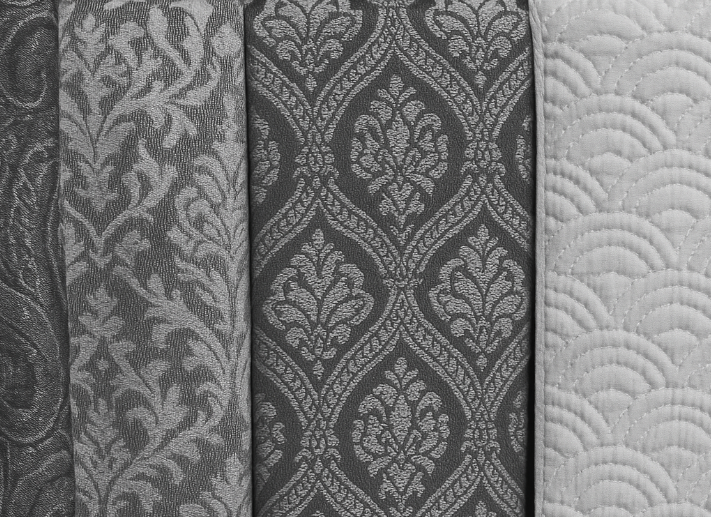
What Is Jacquard Fabric? A Deep Dive Into Weaves, Weight, and Why It’s So Popular Now
Jacquard fabric has been around for centuries, but it still feels modern—and for good reason.
If you’ve ever seen a richly textured fabric with a floral pattern that wasn’t printed or embroidered, chances are you’ve met jacquard. But what exactly is jacquard fabric? How is it made, and why did it once cost a fortune to produce? Let’s unravel the threads.

What Is Jacquard Fabric?
Jacquard fabric refers to any textile that has a woven pattern created directly on the loom—not printed or embroidered after. The designs can be subtle or bold, from classic damask to abstract geometric motifs.
What makes it special is the jacquard loom, which controls each individual warp thread to raise or lower at precise moments, creating intricate patterns.
It’s not a type of fiber (like cotton or silk), but a type of weave structure. Jacquard fabrics can be made from many materials: cotton, polyester, viscose, wool, or blends.
Is Jacquard Fabric Entirely Woven?
Yes—jacquard patterns are created solely through weaving, not surface embellishment.
That means the design is built into the fabric's very structure. Depending on how the warp and weft threads interlace, the pattern emerges visibly on the surface (and often appears reversed on the back).
There are no screens, no dyes, and no embroidery hoops involved. It’s all done through mechanical patterning, thread by thread.

The Main Types of Jacquard Fabric (And What They Look Like)
Jacquard is not one-size-fits-all. The term includes a range of textures and designs. Here are the most common types:
1. Brocade
- Luxurious, often metallic.
- Often used in occasion wear or upholstery.
- Slightly raised pattern, often with a satin sheen.
2. Damask
- Elegant and reversible.
- Usually made from silk, linen, or cotton.
- Used in table linens, curtains, or dress shirts.
3. Matelassé
- Quilted look, but woven as a single layer.
- Soft and pillowy texture.
- Popular in bedding and home décor.
4. Tapestry
- Heavier weight.
- More pictorial or scenery-based patterns.
- Often seen in wall hangings or bags.
5. Stretch Jacquard
- Usually polyester or nylon blend with spandex.
- Used in bodycon dresses, leggings, and performance fashion.
- Textured surface + flexibility.
Jacquard Weaving Structures: The Technical Side
The jacquard weave allows for an incredible range of complexity. Depending on how many warp threads are individually controlled, the structures can vary from simple one-color repeats to highly detailed, multicolored designs.
You may encounter:
- Single-layer plain jacquard: lightweight, crisp, minimal.
- Double-layered weaves: thicker, more dimensional.
- Cut & uncut loop jacquards: often seen in towels or terry cloth.
Why Was Jacquard Once So Expensive?
Back in the 1800s, jacquard fabrics were luxury items. The mechanical loom invented by Joseph Marie Jacquard was revolutionary but expensive to operate. Each design required:
- Thousands of punch cards (pre-digital code!)
- Complex setup
- Highly skilled labor
This made jacquard weaving time-intensive and labor-heavy. Only aristocrats could afford garments or interiors made with it.
How Modern Tech Brought Costs Down
Today, computerized jacquard looms allow designs to be uploaded digitally. You can now weave intricate motifs with far fewer human hours. What once took days can now be produced in minutes. Mass production, synthetic blends, and improved yarn spinning have all lowered the cost barrier.
The result? Jacquard fabric is now found not just in couture, but in:
- Fast fashion
- Sportswear
- Home textiles
- Even airport outfits and elevated basics
Does Jacquard Fabric Come in Different Weights?
Absolutely. One of the best things about jacquard is how versatile it is in terms of weight and drape.
| Type | Typical GSM (grams per square meter) | Use |
|---|---|---|
| Lightweight jacquard | 120–180 GSM | Blouses, shirts, linings |
| Midweight jacquard | 180–260 GSM | Dresses, skirts, pants |
| Heavyweight jacquard | 260–400+ GSM | Outerwear, upholstery, bags |
Some jacquards feel almost paper-thin and crisp, while others are thick and luxurious like a winter coat. Always check the GSM before buying.
Where Can You Buy Jacquard Fabric?
Looking to experiment? Here are a few online sources for jacquard fabrics, depending on your budget and use case:
- Mood Fabrics (USA) – moodfabrics.com
- Minerva (UK) – minerva.com
- Alibaba – For wholesale and sourcing directly from mills
- Etsy – For unique or small-batch jacquards
- Fabric.com – Widely accessible in North America
If you're producing garments at scale or doing sampling, consider sourcing swatches through B2B platforms like SwatchOn or SourceEasy, especially for blends and performance jacquards.
Final Thoughts
Jacquard fabric is proof that weaving is an artform. It merges form and function, surface and structure, tradition and tech. From opulent brocades to minimalist textures, it offers designers and everyday dressers a unique way to express detail, depth, and narrative—without printing a single drop of ink.
Whether you’re looking to make a standout blazer, elevate a lounge set, or upgrade your bedding game, jacquard fabric might just be your next tactile obsession.

